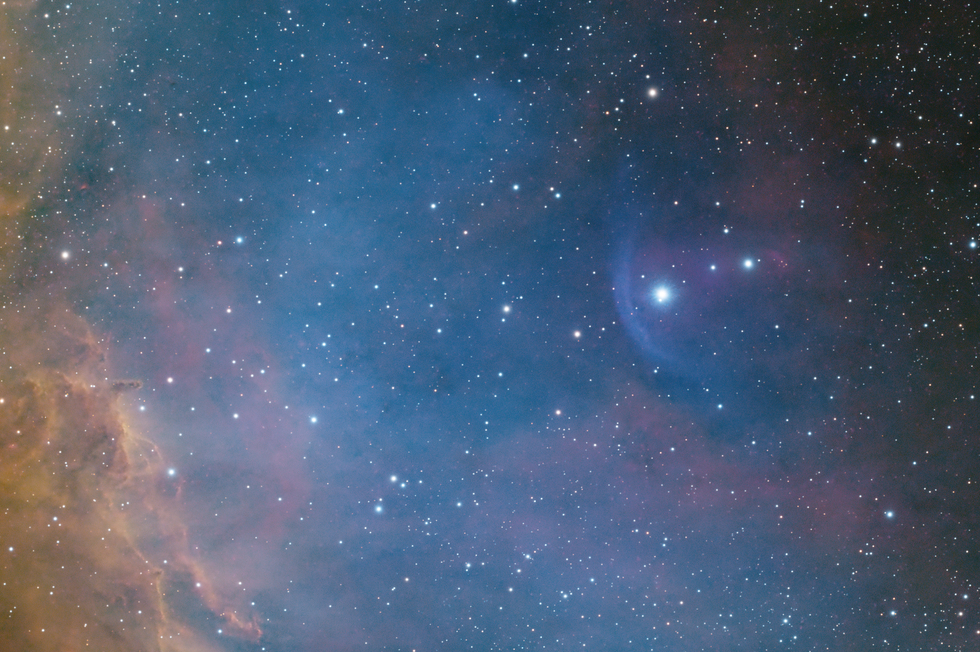Bow Shock
Bow Shock
Seagull Nebula Bow Shock
The Seagull Nebula, located about 3,800 light-years away in the constellations Monoceros and Canis Major, is a vast region of gas and dust where new stars are forming. This active star formation results in various dynamic phenomena, including the Seagull Nebula Bow Shock.
What is a bow shock?
A bow shock occurs when a fast-moving star plows through the surrounding interstellar medium (ISM). The star's powerful stellar wind collides with the ISM, creating a shockwave that heats and compresses the gas, causing it to glow. The shape of the shockwave resembles a bow, hence the name "bow shock."
The Seagull Nebula's runaway star
The Seagull Nebula Bow Shock is created by a runaway star named FN Canis Majoris.This massive star is moving through the nebula at an unusually high speed, likely ejected from a star cluster due to a past supernova explosion or close encounter with another star.
Appearance and characteristics
The bow shock appears as a bright, bluish arc in images of the Seagull Nebula. The blue color comes from the emission of ionized oxygen atoms in the shockwave. The arc is located to the right of the nebula's center, near the "wing" of the seagull-shaped cloud.
Significance
The Seagull Nebula Bow Shock provides valuable insights into the interaction between stars and the interstellar medium. By studying the bow shock, astronomers can learn about the properties of the stellar wind, the speed of the star, and the composition of the ISM. Additionally, bow shocks can trigger further star formation in the surrounding region.
Here are some additional points of interest:
The Seagull Nebula is a complex region with various other phenomena, including H II regions, star clusters, and dark clouds.
The bow shock is just one example of the dynamic processes occurring in the nebula.
The Seagull Nebula is a popular target for amateur astronomers and astrophotographers due to its beautiful and intricate structure.
Takahashi FSQ 106ED f/5 530mm focal length telescope
QHY 600m camera
Data acquired by Telescope Live, in Australia
6 hours total integration
The Seagull Nebula, located about 3,800 light-years away in the constellations Monoceros and Canis Major, is a vast region of gas and dust where new stars are forming. This active star formation results in various dynamic phenomena, including the Seagull Nebula Bow Shock.
What is a bow shock?
A bow shock occurs when a fast-moving star plows through the surrounding interstellar medium (ISM). The star's powerful stellar wind collides with the ISM, creating a shockwave that heats and compresses the gas, causing it to glow. The shape of the shockwave resembles a bow, hence the name "bow shock."
The Seagull Nebula's runaway star
The Seagull Nebula Bow Shock is created by a runaway star named FN Canis Majoris.This massive star is moving through the nebula at an unusually high speed, likely ejected from a star cluster due to a past supernova explosion or close encounter with another star.
Appearance and characteristics
The bow shock appears as a bright, bluish arc in images of the Seagull Nebula. The blue color comes from the emission of ionized oxygen atoms in the shockwave. The arc is located to the right of the nebula's center, near the "wing" of the seagull-shaped cloud.
Significance
The Seagull Nebula Bow Shock provides valuable insights into the interaction between stars and the interstellar medium. By studying the bow shock, astronomers can learn about the properties of the stellar wind, the speed of the star, and the composition of the ISM. Additionally, bow shocks can trigger further star formation in the surrounding region.
Here are some additional points of interest:
The Seagull Nebula is a complex region with various other phenomena, including H II regions, star clusters, and dark clouds.
The bow shock is just one example of the dynamic processes occurring in the nebula.
The Seagull Nebula is a popular target for amateur astronomers and astrophotographers due to its beautiful and intricate structure.
Takahashi FSQ 106ED f/5 530mm focal length telescope
QHY 600m camera
Data acquired by Telescope Live, in Australia
6 hours total integration
SPECIFICATIONS
Telescope
AUS-2 CMOS
Camera
QHY 600m
Location
Yass, NSW 2582, Australia
Date of observation
Bundle
Filters
SHO
Processing
Pixinsight
Credits
Telescope Live/ Fred Zimmer



